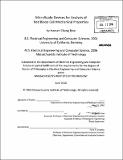Microfluidic devices for analysis of red blood cell mechanical properties
Author(s)
Bow, Hansen Chang
DownloadFull printable version (15.38Mb)
Alternative title
Microfluidic devices for analysis of RBC mechanical properties
Analysis of red blood cell mechanical properties
Other Contributors
Massachusetts Institute of Technology. Dept. of Electrical Engineering and Computer Science.
Advisor
Jongyoon Han.
Terms of use
Metadata
Show full item recordAbstract
Decreased deformability of human red blood cells (RBCs) is both a cause of disease and biomarker for disease (1). To traverse blood capillaries, the biconcave disk-shaped RBC must deform dramatically, since the diameter of the unconstrained RBC is larger than that of the capillaries. If the RBC becomes immobilized in a capillary, hypoxia and tissue injury may result, potentially leading to death. Changes in RBC deformability may be attributable to genetics (e.g. sickle cell anemia (2) and spherocytosis (3)), drug exposure (e.g. pentoxifylline (4)), and disease (e.g. diabetes (5) and malaria (6)). Within the past 15 years, microfabrication techniques have enabled the creation of pores comparable in size and shape to the smallest human capillaries (7) and slits in the spleen (8). We use this microfabrication ability to create devices that analyze and separate RBCs of different deformability. The first device we create is an automated 'deformability cytometer' that measures dynamic mechanical responses of 103~104 individual cells in a cell population. Fluorescence measurements of each cell are simultaneously acquired, resulting in a population-based correlation between biochemical properties (e.g. cell surface markers) and dynamic mechanical deformability. This device is especially applicable to heterogeneous cell populations, and we demonstrate its ability to mechanically characterize a small number of ring-stage malaria-infected RBCs in a large population of healthy RBCs. Next we present a device whose design is based on the architecture of the human spleen. This device is able to continuously separate more deformable from less deformable RBCs. We demonstrate the ability of this device to separate schizont-stage malaria-infected RBCs from healthy RBCs. Together, these devices enable the analysis and separation of single-RBCs based on deformability.
Description
Thesis (Ph. D.)--Massachusetts Institute of Technology, Dept. of Electrical Engineering and Computer Science, 2010. Cataloged PDF version of thesis. Includes bibliographical references (p. 118-126).
Date issued
2010Department
Massachusetts Institute of Technology. Department of Electrical Engineering and Computer SciencePublisher
Massachusetts Institute of Technology
Keywords
Electrical Engineering and Computer Science.